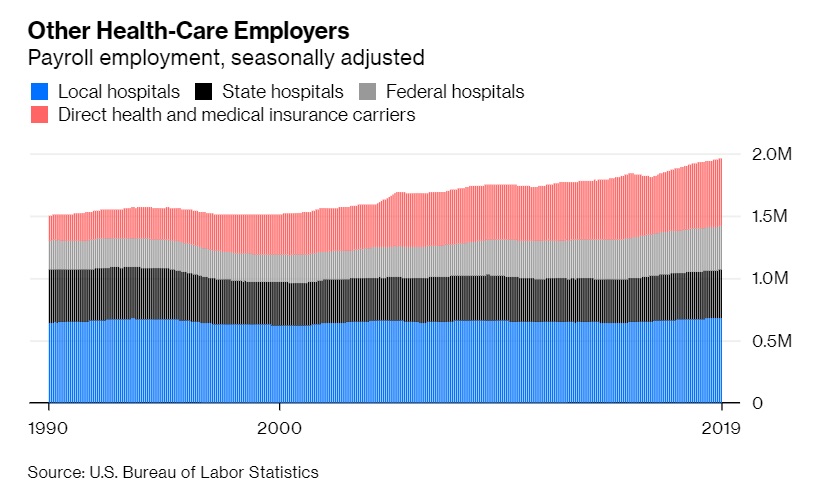 Is the slight uptick over the past eight months in health care's share of employment a signal of something bigger? (Photo: Shutterstock)
Is the slight uptick over the past eight months in health care's share of employment a signal of something bigger? (Photo: Shutterstock)
Of the 263,000 nonfarm payroll jobs that the Bureau of Labor Statistics estimates were created in April, 27,000 were in health care.
This is not really news: Since the beginning of 2015, the average monthly gain in health-care jobs has been 28,959. Since 2010, it's been 23,893; since 2000, it's been 24,041; since 1990, it's been 23,709. Only four of the 351 months since January 1990 have seen declines in health-care employment.
That kind of consistency is in itself somewhat newsworthy, though. Most industries don't behave like that! Here's the growth in health-care employment since 1990 compared with job growth in the rest of the economy:

During recessions, employment declines. But over the past three recessions, employment in the health-care sector kept on rising. One result is that, while health care's share of nonfarm payroll employment has risen from 7.3 percent in January 1990 to 10.8 percent today, those gains have almost all come during and immediately after economic downturns.
 The slight uptick over the past eight months in health care's share — if you stretch things out to two decimal points, it has gone from 10.73 percent in August to 10.81 percent in April — is interesting. I certainly wouldn't call it a recession signal, but it's worth keeping an eye on.
The slight uptick over the past eight months in health care's share — if you stretch things out to two decimal points, it has gone from 10.73 percent in August to 10.81 percent in April — is interesting. I certainly wouldn't call it a recession signal, but it's worth keeping an eye on.
The BLS health-care-sector numbers don't include health insurers or government hospitals. Add them in (which I didn't do in the above charts in part because there are no April data available for them yet), and health care accounts for 12.1 percent of payroll employment. But government hospital employment has grown only modestly since 1990, and while employment at health insurers has grown a spectacular 174 percent, it's still a pretty small part of overall health-care employment.
The gains in health-care employment are great news if you want a job in health care. So is the fact that weekly earnings in the sector, which were lower than those for private employers overall in 1990, are now about 13 percent higher for non-supervisory workers, a premium that arose in the 2000s and has stayed about the same since 2009.
All this good news for health-care workers is not necessarily good news for the U.S. economy, though. Health care is a low-productivity-growth sector that, over time, has arguably been a drag on other U.S. industries. Plus, its share of employment can't keep growing forever, right? A 27,000-job gain doesn't mean as much when employment is at 16 million as when it's at 8 million, so the percentage increases in health-care employment are smaller now than in the 1990s and 2000s. But they've still been higher in most recent months (not April, when the two were pretty much even) than the gains for total nonfarm payroll employment. The end of the health-care boom is not yet in sight.
Justin Fox ([email protected]) is a Bloomberg Opinion columnist covering business. He was the editorial director of Harvard Business Review and wrote for Time, Fortune and American Banker. He is the author of “The Myth of the Rational Market.” This column does not necessarily reflect the opinion of the editorial board or Bloomberg LP and its owners. To contact the editor responsible for this story: Brooke Sample at [email protected]
Read more:
© Touchpoint Markets, All Rights Reserved. Request academic re-use from www.copyright.com. All other uses, submit a request to [email protected]. For more inforrmation visit Asset & Logo Licensing.






